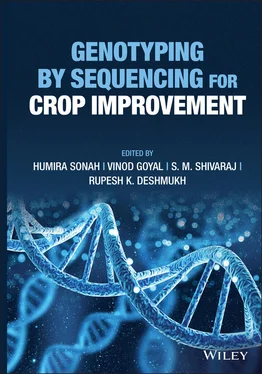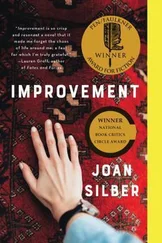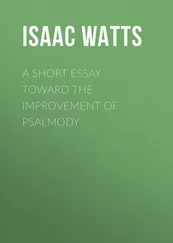Genotyping by Sequencing for Crop Improvement
Здесь есть возможность читать онлайн «Genotyping by Sequencing for Crop Improvement» — ознакомительный отрывок электронной книги совершенно бесплатно, а после прочтения отрывка купить полную версию. В некоторых случаях можно слушать аудио, скачать через торрент в формате fb2 и присутствует краткое содержание. Жанр: unrecognised, на английском языке. Описание произведения, (предисловие) а так же отзывы посетителей доступны на портале библиотеки ЛибКат.
- Название:Genotyping by Sequencing for Crop Improvement
- Автор:
- Жанр:
- Год:неизвестен
- ISBN:нет данных
- Рейтинг книги:4 / 5. Голосов: 1
-
Избранное:Добавить в избранное
- Отзывы:
-
Ваша оценка:
- 80
- 1
- 2
- 3
- 4
- 5
Genotyping by Sequencing for Crop Improvement: краткое содержание, описание и аннотация
Предлагаем к чтению аннотацию, описание, краткое содержание или предисловие (зависит от того, что написал сам автор книги «Genotyping by Sequencing for Crop Improvement»). Если вы не нашли необходимую информацию о книге — напишите в комментариях, мы постараемся отыскать её.
A thoroughly up-to-date exploration of genotyping-by-sequencing technologies and related methods in plant science Genotyping by Sequencing for Crop Improvement,
Genotyping by Sequencing for Crop Improvement
Genotyping by Sequencing for Crop Improvement
Genotyping by Sequencing for Crop Improvement — читать онлайн ознакомительный отрывок
Ниже представлен текст книги, разбитый по страницам. Система сохранения места последней прочитанной страницы, позволяет с удобством читать онлайн бесплатно книгу «Genotyping by Sequencing for Crop Improvement», без необходимости каждый раз заново искать на чём Вы остановились. Поставьте закладку, и сможете в любой момент перейти на страницу, на которой закончили чтение.
Интервал:
Закладка:
Another important pipeline widely used for NGS data analysis is dDocent pipeline ( www.dDocent.com) which is a simple bash wrapper to quality analysis, assemble, map, and call SNPs from almost any kind of RAD sequencing (Puritz et al. 2014). However, most of these pipelines are hard to code for a student with little bioinformatics background. Most of these pipelines vary with respect to the complexity of the genome and computational space required. Besides there are several bioinformatics tools such as BWA, Bowtie2, SAM tools, GATK, BCFtools including a set of Perl utility scripts (Kagale et al. 2016) that can be used for GBS data analysis. However, there should be knowledge of the installation and usage of these tools for proper utilization in data analysis. With the advancements in NGS approaches, GBS has become a widely used approach in plant breeding and genetics, particularly for understanding complex quantitative traits.
DArT‐seq GBS ( https://www.diversityarrays.com/technology‐and‐resources/dartseq/) somehow overcomes the limitation of the missing data point. The technique is an extension of traditional DArT technology where DArT representations are sequenced on the NGS platform. The fragment sequencing enables a dramatic increase in the number of genomic fragments analyzed and an increase in the number of reported markers thus making it a cost‐effective technology than the initial DArT method.
1.5.2 Whole‐Genome Resequencing (WGR)
WGR with high coverage and depth overcomes the limitations of GBS due to missing data points and heterozygous calls. In general, WGR involves the sequencing of enough DNA fragments (>5×–20×) to cover the whole genome of an organism. Due to sequencing cost, the technique is suitable in crop plants having smaller genome sizes such as rice. In such cases, GBS can be replaced by resequencing of a larger size population at 5–6× depth. However, WGR for few samples can be done at a much higher read depth of 10–20× as in the case of the BSA‐seq approach (Nguyen et al. 2019). One of the important BSA‐seq‐based approaches is quantitative trait loci (QTL)‐seq developed by Takagi et al. (2015) in rice. Later this technique has been widely used in several crop plants. Takagi et al. (2015) developed a pipeline for analysis of the whole genome sequence of bulks and identification of causative variants. WGR has been used in several studies for identification of genome‐wide SNPs, genotyping mapping populations for construction of high‐density linkage maps and QTL mapping, linkage and genome‐wide association studies (GWASs), of reference genome improvement, and genomic selection (Poland and Rife 2012; Bhatia et al. 2013; Chung et al. 2017; Nguyen et al. 2019).
1.5.3 SNP Arrays
Along with GBS, high‐density DNA array‐based SNP chips or SNP arrays have become a widely used SNP detection platform for high multiplex genotyping. SNP arrays work by hybridization of DNA fragments with allele‐specific oligonucleotide probes (SNP probes) and fluorescence‐based detection of signals. In general, SNP arrays can be roughly categorized into two types based on SNP detection methods: (i) nonenzymatic differential hybridization including allele‐specific hybridization, (ii) enzymatic reactions including primer extension, and mini‐sequencing (Ding and Jin 2009). For making SNP arrays, the first step is the identification of genome‐wide SNPs by sequencing (preferably WGR) of a large diverse panel. The SNPs arrays may include SNPs from coding (genic) regions only and/or genome‐wide SNPs from other noncoding regions. SNPs are in silico validated with several custom tools and final filtered SNPs are identified. The oligonucleotide probes containing SNP alleles are designed and bound on a solid glass plate surface. SNP chips can be custom designed commercially from two widely used platforms: Affymetrics ( www.affymetrics.com) as Axiom Affymetrics SNP Chips (Affymetrix/Thermo Fisher Axiom ®) or Illumina ( https://www.illumina.com/science/technology/microarray.html) as Immunia Infinium assay (Illumina Infinium ®). Affymetrics SNP array relies on differential hybridization due to different melting temperatures for matched and mismatched SNPs binding to target DNA sequence. On the other hand, Illumina Infinium assay uses Illumina BeadArray technology that relies on primer extension to distinguish two SNP alleles. The Affymetrix SNP array uses 25‐mer for SNP calling while the Illumina BeadArray uses 50‐mer for target capture. In rice, a high‐resolution 44K Affymetrix array, 50K Infinium array, and 700K high‐density rice array are available for rice SNP genotyping (McCouch et al. 2010; Tung et al. 2010; Chen et al. 2013; McCouch et al. 2015). Additionally, high‐density SNP arrays have been developed for other crop plants such as maize (Ganal et al. 2011) and sunflower (Bachlava et al. 2012) as well as domestic animal species, including cattle (Gibbs et al. 2009; Matukumalli et al. 2009) and pig (Ramos et al. 2009). One major advantage of SNP arrays is the reproducibility of data points where GBS does have some shortcomings. However, the disadvantage is the less polymorphism as compared to GBS and WGR and detection of only alleles present in the array ( Table 1.2).
Table 1.2 Comparison between different marker techniques commonly used in plant research.
| SSR | GBS | WGR | SNP array | KASP™ | |
|---|---|---|---|---|---|
| DNA quality | Moderate | High | High | High | High |
| PCR‐based | Yes | Yes | No | No | No |
| Allele detection | High | High | High | Low | Low |
| Polymorphism | High | High | High | Low | Low |
| Ease to use | Easy | Not easy | Not easy | Easy | Easy |
| Reproducibility | High | Low | High | High | High |
| Cost | Moderate | Low to moderate | High | High | moderate |
| Cost for analysis | High | High | High | Low | Low |
| Suitability for different approaches | |||||
| Genetic diversity analysis | High | Moderate | High (cost concerns) | High | High |
| Bi‐parental QTL mapping | High | High | High | High | High |
| Genome wide association analysis | Moderate | High | High | High | Low |
| Genomic selection | Low | Moderate | High (cost concerns) | High | Low |
1.5.4 Kompetitive Allele‐Specific PCR (KASP ™)
KASP ™is a trademark technology of KBiosciences ( http://www.kbioscience.co.uk/) or LGC genomics ( http://www.lgcgenomics.com) initially developed for in‐house genotyping, thereafter evolving as a benchmark technology for SNP genotyping. Any candidate SNP identified through GBS or WGR and associated with any important traits can be validated through KASP assay. Furthermore, any identified candidate SNP associated with a trait of interest can be readily converted into KASP assay to serve as a robust and cost‐effective marker to be used as a MAS tool for crop improvement. It works on the principle of competitive allele‐specific PCR permitting bi‐allelic scoring of SNP, insertion, and deletions (InDels) at a specific location in the genome ( Figure 1.2). KASP genotyping reaction consists of DNA sample, KASP assay mix, and universal KASP master mix. Allele‐specific two forward primers and common reverse primer all unlabelled constitute KASP assay mix. Allele‐specific primers have a unique tail sequence complementary to FRET (fluorescence resonant energy transfer) cassette. Each allele harbors a tail sequence linked to different dyes (FAM™ and HEX™ dyes). KASP master mix has FRET cassettes in the quenched state, a passive reference dye (ROX™), and other components for PCR reaction. During the first round of reaction allele‐specific primer binds to template incorporating tail sequence in newly synthesized strands. In the next round of PCR, a complementary strand of the allele‐specific tail sequence is generated allowing the FRET cassette to bind enabling an unquenched state, and generating a fluorescent allele‐specific signal. In the case of a homozygous DNA sample, only one signal specific to the allele is seen and mixed signal is generated in the case of the heterozygous individual. It can be carried out in 96‐ to 1536‐well plate format. Application of KASP includes QC (quality control) analysis, QTL mapping, allele mining (Semagn et al. 2013), and MAS. However, it may not be a suitable platform for genome‐wide association mapping and genomic selection due to fewer data points. KASP markers have been utilized extensively for MAS in major crops like rice (Yang et al. 2019; Kang et al. 2019), wheat (Makhoul et al. 2020; Fang et al. 2020; Grewal et al. 2020), and maize (Zhang et al. 2017; Su et al. 2016).
Читать дальшеИнтервал:
Закладка:
Похожие книги на «Genotyping by Sequencing for Crop Improvement»
Представляем Вашему вниманию похожие книги на «Genotyping by Sequencing for Crop Improvement» списком для выбора. Мы отобрали схожую по названию и смыслу литературу в надежде предоставить читателям больше вариантов отыскать новые, интересные, ещё непрочитанные произведения.
Обсуждение, отзывы о книге «Genotyping by Sequencing for Crop Improvement» и просто собственные мнения читателей. Оставьте ваши комментарии, напишите, что Вы думаете о произведении, его смысле или главных героях. Укажите что конкретно понравилось, а что нет, и почему Вы так считаете.












